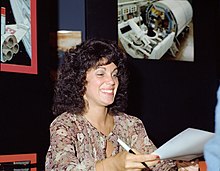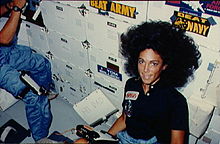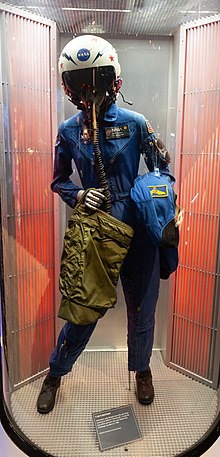Judith Resnik
Judith Resnik | |
|---|---|
NASA astronaut | |
Time in space | 6d 0h 56m |
| Selection | NASA Group 8 (1978) |
| Missions | STS-41-D STS-51-L (Space Shuttle Challenger disaster) |
Mission insignia |  |
| Scientific career | |
| Thesis | Bleaching Kinetics of Visual Pigments (1977) |
| Doctoral advisor | Felix Zajac |
Judith Arlene Resnik (April 5, 1949 – January 28, 1986) was an American
Recognized while still a child for her intellectual brilliance, Resnik was accepted at
Resnik worked for
At age 28, Resnik was selected by NASA as a mission specialist. She was part of NASA Astronaut Group 8, the first group to include women. While training on the astronaut program, she developed software and operating procedures for NASA missions. Her first space flight was the STS-41-D mission in August and September 1984, the twelfth Space Shuttle flight, and the maiden voyage of Space Shuttle Discovery, where her duties included operating its robotic arm. Her second Shuttle mission was STS-51-L in January 1986 aboard Space Shuttle Challenger. She died when the orbiter broke up shortly after liftoff and crashed into the ocean.
Early life
Judith Arlene Resnik was born in
Resnik was noticed for her intellectual ability while still in kindergarten, and she entered elementary school a year early.
Although her mother disapproved of her dating, Resnik had a series of boyfriends. She preferred to socialize with boys from the nearby Copley High School rather than from Firestone, where her intellectual reputation preceded her. She met Len Nahmi (who eventually became a pilot)[18] at a basketball game. He was half Irish and half Lebanese, and her mother disapproved of him. Nonetheless, she continued to see him secretly, and when she stayed with a cousin in Cleveland while taking a college course available to high school students, she also met with him there. Her parents acrimoniously divorced while she was a teenager, and custody was given to her mother, as was the custom in the United States. Her mother's dislike of Nahmi became more intense, and Nahmi eventually ended their relationship to spare Resnik more pain. When she was 17, she prepared and filed a successful court case so that her custody could be switched from her mother to her father, with whom she was particularly close. She tore up letters from her mother unopened.[19][20] Her father remarried, and she acquired twin stepsisters, Linda and Sandy, who were nine years older than she was, and with whom she became close.[21]

At age 17, Resnik entered
Resnik married Oldak on July 14, 1970.
While working on her doctorate, Resnik switched jobs in 1974, and went to work as a
NASA astronaut
Selection and training

After her divorce from Oldak, Resnik reconnected with Nahmi, who was now a commercial airline pilot. When he heard that the
Resnik's mentor and advisor, Professor
In January 1978, at age 28, Resnik was selected as a
Resnik worked on research into the principle of orbital systems, flight software and the development of systems of manual control of spacecraft. She developed the
Other astronauts felt that either Resnik or
STS-41-D


In February 1983, Resnik was assigned to the crew of STS-41-D, the twelfth Space Shuttle flight, the maiden voyage of the Space Shuttle Discovery, along with Henry Hartsfield, Michael Coats, Steven Hawley and Mike Mullane.[39][40] During a visit to a contractor's factory, Resnik whispered to Mullane: "there are no maidens on this flight".[41] She was the center of attention on such visits, and one contractor engineer became a stalker, sending her unwelcome letters, poems and gifts. Eventually, after he appeared in the office, he had to be dealt with by NASA security.[42][i] After Hawley and Mullane had a fawning encounter with actor Bo Derek, who was working on the film Tarzan, the Ape Man, Resnik started calling Mullane "Tarzan" and Hawley "Cheetah";[44][45] when the office secretaries heard about this, they began referring to the STS-41-D crew as the "zoo crew".[46] Resnik was a fan of the actor Tom Selleck, and had a coffee cup that said: "Excuse No. 1: I'm Saving Myself for Tom Selleck."[47] Her crewmates hid a poster of Tom Selleck behind the bathroom curtain on Discovery.[48]
The STS-41-D mission's launch was delayed three times. The first attempt, on June 25, 1984, was aborted due to a failure of the backup computer. The following day, during the second attempt, the computer detected a fault in one of the
Resnik became the second American woman in space. She was also the first
That day Resnik also deployed the OAST-1 solar array wing,[49] considered a potential future way of generating more electrical power during space missions. After performing several dynamic tests that day and the next, she reported that the experiment was well-behaved and matched ground simulations of the array.[56] During the mission, she held up a hand-written sign saying "Hi Dad" to the cameras, and in a live televised broadcast told President Ronald Reagan "the Earth looks great". When Reagan asked her if the flight was all she hoped it would be, she replied, "It certainly is and I couldn't have picked a better crew to fly with."[56] After the mission, Hartsfield described Resnik as the "astronaut's astronaut",[10] and Mullane wrote: "I was also happy to be crewed with Judy ... She was smart, hardworking, and dependable, all the things you would want in a fellow crewmember."[57]
Discovery landed at Edwards Air Force Base on September 5, after a flight lasting 6 days and 56 minutes.[49]
Space Shuttle Challenger disaster
On January 29, 1985, NASA announced that Resnik had been assigned to the crew of
Initially scheduled for January 24, 1986, the launch was delayed until January 28 by rain, high winds, a troublesome bolt on the Space Shuttle Challenger's hatch and freezing temperatures.[63] Resnik's father and stepmother, and her brother and his family watched the launch from the VIP area, as did her Firestone High math teacher. Selleck declined her invitation to attend. Resnik carried a locket for her niece, a signet ring for her nephew and a cigarette lighter for Nahmi.[64]
Challenger lifted off from
Following the disaster, examination of the recovered vehicle cockpit revealed that the
Mike Smith's PEAP had been turned on by Judy or El, I wondered if I would have had the presence of mind to do the same thing had I been in Challenger's cockpit. Or would I have been locked in a catatonic paralysis of fear? There had been nothing in our training concerning the activation of a PEAP in the event of an in-flight emergency. The fact that Judy or El had done so for Mike Smith made them heroic in my mind. They had been able to block out the terrifying sights and sounds and motions of Challenger's destruction and had reached for that switch. It was the type of thing a true astronaut would do—maintain their cool in the direst of circumstances.[68]
This is the only evidence that shows Onizuka and Resnik were alive after the cockpit separated from the vehicle. If the cabin had lost pressure, the air packs alone would not have sustained the crew during the two-minute descent.[69] Resnik's remains were recovered from the crashed vehicle cockpit by Navy divers from the USS Preserver [70] and they were cremated and scattered over the water.[71] The unidentified remains of the seven crew members were cremated and buried at the Space Shuttle Challenger Memorial in Arlington National Cemetery on May 20, 1986.[72]
Legacy

Resnik was posthumously awarded the
A memorial to Resnik and the rest of the crew of Challenger was dedicated in
See also
- List of female astronauts
Footnotes
- ^ In 2003, Franz Stephan Strambach, a deranged man obsessed with Resnik, threatened to crash his aircraft into the Seat of the European Central Bank in Frankfurt, Germany. He was talked down after a telephone call to Resnik's relatives in the United States, during which he discussed a tribute page he had created for her on the World Wide Web.[43]
- attitude direction indicator from low-vertical to low-horizontal flight mode in case they had to make an emergency abort.[67]
Notes
- ^ a b c "Biographical Data – Judith A. Resnik (Ph.D.) NASA astronaut (deceased)" (PDF). NASA. Retrieved February 27, 2020.
- ^ a b Resnik, Judith (1977). Bleaching kinetics of visual pigments (PhD thesis). University of Maryland. Retrieved February 27, 2022 – via Worldcat.
- ^ a b Green, David B. (April 5, 2015). "This Day in Jewish History / Female astronaut who would die in shuttle explosion is born". Haaretz. Retrieved February 27, 2022.
- ^ "Sarah Resnik Belfer, mother of astronaut Judith Resnik, was 89". Cleveland Jewish News. March 18, 2011. Retrieved March 13, 2022.
- ^ "A brother's emotional remembrance: 'Judy was brilliant'". WBALTV. January 28, 2016. Retrieved February 27, 2022.
- ^ Kolbert, Elizabeth (February 9, 1986). "Two Paths to the Stars: Turnings and Triumphs; Judith Resnik". The New York Times. p. 1. Retrieved March 13, 2022.
- ^ Bernstein, Blue & Gerber 1990, p. 9.
- ^ "Marvin Resnik, father of Challenger astronaut Judith Resnik, was 90". Cleveland Jewish News. March 18, 2010. Retrieved February 25, 2022.
- ^ et al. 1990, p. 12.
- ^ a b c d e f g h i j Cavallaro 2017, pp. 28–31.
- ^ a b Bernstein, Blue & Gerber 1990, p. 10.
- ^ Bernstein, Blue & Gerber 1990, p. 14.
- ^ Ware & Braukman 2004, p. 426.
- ^ a b "Judith Resnik (1949–1986)". Jewish Virtual Library. Retrieved February 25, 2022.
- ^ a b Gibson 2014, pp. 91–94.
- ^ a b c d e Swaney, Chriss (March 1, 2011). "Judy Resnik: Family, Friends Remember Engineer Who Reached for the Stars". The Piper. Carnegie Mellon University. Retrieved February 27, 2022.
- ^ a b c Ferraro, Thomas (February 3, 1986). "Although their marriage ended in divorce in 1976, Michael..." UPI. Retrieved February 27, 2022.
- ^ "Local News in Brief : Pilot Alleges Conspiracy". Los Angeles Times. November 27, 1987.
- ^ a b c d e Spencer, Scott; Spolar, Chris (January 16, 1987). "The Epic Flight of Judith Resnik". Esquire. Retrieved February 27, 2022.
- ^ Bernstein, Blue & Gerber 1990, pp. 22–25.
- ^ a b Bernstein, Blue & Gerber 1990, pp. 26–27.
- ^ "Remembering the Challenger". The Ohio Historical Society Collections Blog. Archived from the original on January 5, 2016.
- ^ "About". Mortar Board. Retrieved March 15, 2024.
- ^ a b c Bernstein, Blue & Gerber 1990, pp. 28–30.
- ^ Bernstein, Blue & Gerber 1990, pp. 28–29.
- PMID 712451.
- ^ Bernstein, Blue & Gerber 1990, pp. 32–33.
- ^ Renner, Lisanne (January 29, 1986). "Coverage from the day space shuttle Challenger exploded: Resnik liked a job label with no frills". Orlando Sentinel. Retrieved July 3, 2013.
- ^ a b Bernstein, Blue & Gerber 1990, p. 34.
- ^ Atkinson & Shafritz 1985, pp. 163–165.
- ^ Bernstein, Blue & Gerber 1990, pp. 38–39.
- ^ Siceloff, Steven (April 20, 2011). "T-38s Soar as Spaceflight Trainers". NASA. Retrieved June 15, 2022.
- ^ a b Seddon, Rhea (May 21, 2010). "Rhea Seddon Oral History" (Interview). Interviewed by Jennifer Ross-Nazzal. Murfreesboro, Tennessee. Retrieved March 16, 2022.
- ^ Tietjen 2017, p. 72.
- ^ Bernstein, Blue & Gerber 1990, p. 40.
- ^ Evans 2012, p. 249.
- ^ Shayler & Burgess 2020, pp. 290–293.
- ^ Shayler & Moule 2006, pp. 198–199.
- ^ Lawrence, John (February 4, 1983). "STS-11 and STS-12 Crews Named" (PDF) (Press release). NASA. 83-003. Retrieved March 17, 2022.
- ^ Mullane 2006, pp. 111–113.
- ^ Mullane 2006, p. 114.
- ^ Mullane 2006, p. 115.
- ^ "Frankfurt flier 'has astronaut fixation'". BBC News. January 6, 2003. Retrieved June 15, 2022.
- ^ Mullane 2006, pp. 90–91.
- ^ Talley, Olive (June 23, 1984). "Discovery's crew includes woman". UPI Archives. Retrieved March 20, 2022.
- ^ Mullane 2006, pp. 115–116.
- ^ Bernstein, Blue & Gerber 1990, p. 55.
- ^ Bernstein, Blue & Gerber 1990, p. 53.
- ^ a b c d e f "35 Years Ago: STS-41D – First Flight of Space Shuttle Discovery". NASA. August 27, 2019. Retrieved March 19, 2022.
- ^ Bernstein, Blue & Gerber 1990, p. 52.
- ^ Bernstein, Blue & Gerber 1990, p. 47.
- ^ Wayne 2011, p. 796.
- ^ Mullane 2006, p. 173.
- ^ Mullane 2006, pp. 177–178.
- ^ Evans 2012, pp. 263–264.
- ^ a b Shayler & Moule 2006, pp. 216–218.
- ^ Mullane 2006, p. 112.
- ^ Redmond, Charles; White, Terry (January 29, 1985). "NASA Names Crews to Deploy Satellites in Year-End Flight" (PDF) (Press release). NASA. 85-005. Retrieved March 20, 2022.
- ^ a b "Space Shuttle Missions STS-51-L Press Kit". NASA. January 1986. Retrieved March 20, 2022.
- ^ Evans 2012, p. 444.
- ^ Bernstein, Blue & Gerber 1990, pp. 64–67.
- ^ Mullane 2006, p. 214.
- ^ Broad, William J. (January 28, 1986). "24-Hour Delay Called For Shuttle Flight As Wind and Balky Bolt Bar Launching". The New York Times. p. 3. Retrieved March 20, 2022.
- ^ Bernstein, Blue & Gerber 1990, pp. 71–73.
- ^ Bernstein, Blue & Gerber 1990, pp. 79–85.
- ^ NASA (May 24, 2010). Ascent Checklist – STS-134 (PDF) (Report) (Final ed.). Houston, Texas: Lyndon B. Johnson Space Center. p. FB 2-5. JSC-48005-134. Retrieved June 13, 2022.
- ^ United Space Alliance (December 15, 2008). Shuttle Crew Operations Manual (PDF) (Report). NASA. pp. 2.7-3–2.7-6. USA007587. Retrieved June 13, 2022.
- ^ Mullane 2006, p. 275.
- ^ Kerwin, Joseph. "Letter from Joseph Kerwin to Richard Truly relating to the deaths of the astronauts in the Challenger accident". NASA. Retrieved October 20, 2009.
- ^ Broad, William J. (March 10, 1986). "Navy Divers Sight Astronaut Cabin; Dead are Aboard". The New York Times. Retrieved February 27, 2022.
- ^ "Some Fear Learning How Loved Ones Died : Crew Discovery Upsets Shuttle Kin". Los Angeles Times. March 16, 1986. Retrieved February 11, 2024.
- ^ "Space Shuttle Challenger Memorial". Arlington National Cemetery. Retrieved February 27, 2022.
- ^ Jacobs, Bob; Mahone, Glenn (July 23, 2004). "Challenger Crew Honored With Congressional Space Medal Of Honor". NASA. Retrieved November 15, 2020.
- ^ "Resnik House – Housing & Residential Education – Student Affairs". Carnegie Mellon University. Retrieved March 14, 2022.
- ^ "Judith A. Resnik ES". Montgomery Schools. Retrieved March 14, 2022.
- ^ "About Us – Resnik CLC K-5". Judith A. Resnik Community Learning Center. Retrieved March 14, 2022.
- ^ Friedman, Courtney (August 18, 2016). "Southwest ISD names middle school after Challenger astronaut Judith Resnik". KSAT. Retrieved February 27, 2022.
- ^ "Challenger Astronauts Memorialized on the Moon". NASA. January 28, 2011. Retrieved February 27, 2022.
- ^ Schmemann, Serge (February 2, 1986). "Soviet Union to Name 2 Venus Craters for Shuttle's Women". The New York Times. Retrieved February 27, 2022.
- ^ Sullivan, Walter (March 27, 1986). "Seven Asteroids are Named for Crew of the Space Shuttle". The New York Times. Retrieved March 14, 2022.
- ^ Hooper, Celia (March 21, 1987). "Memorial dedicated to Challenger crew". UPI Archives. Retrieved February 27, 2022.
- ^ Kelly, Emre (January 30, 2020). "At NASA's Day of Remembrance, 25 names are forever remembered at KSC". Florida Today. Retrieved June 12, 2022.
- IEEE. Retrieved June 23, 2009.
- ^ "Resnik Challenger Medal". Society of Women Engineers. Archived from the original on January 20, 2021. Retrieved March 21, 2022.
- ^ Tonguette, Peter. "'Ohioans in Space' painting features Neil Armstrong, John Glenn, Jim Lovell, Judith Resnik". The Columbus Dispatch. Retrieved January 28, 2024.
- ^ "Who We Are". Challenger.org. Retrieved January 15, 2018.
- ^ "Resnik, Charles". University of Maryland School of Medicine. Retrieved January 15, 2018.
- ^ "Charles Resnik". Challenger.org. Retrieved January 15, 2018.
- ^ Froelich, Janis D. (February 23, 1990). "Challenger is Too Boosterish". Tampa Bay Times. Retrieved February 27, 2022.
References
- Atkinson, Joseph D.; Shafritz, Jay M. (1985). The Real Stuff: A History of NASA's Astronaut Recruitment Program. Praeger special studies. New York: Praeger. OCLC 12052375.
- Bernstein, Joanne E; Blue, Rose; Gerber, Alan Jay (1990). Judith Resnik, Challenger Astronaut. New York: Lodestar Books. OCLC 20594024.
- Cavallaro, Umberto (2017). Women Spacefarers: Sixty Different Paths to Space. Chichester: Springer. OCLC 1066696221.
- Evans, Ben (2012). Tragedy and Triumph in Orbit: The Eighties and Early Nineties. New York: Springer. OCLC 816202257.
- Gibson, Karen (2014). Women in Space: 23 Stories of First Flights, Scientific Missions, and Gravity-Breaking Adventures. Chicago: Chicago Review Press. OCLC 1111936104.
- OCLC 237049278.
- Shayler, David; Moule, Ian A. (2006). Women in Space – Following Valentina. New York: Springer. OCLC 218506039.
- Shayler, David J.; OCLC 1145568343.
- Tietjen, Jill S. (2017). Engineering Women: Re-visioning Women's Scientific Achievements and Impacts. Cham, Switzerland: Springer. OCLC 1105279881.
- Ware, Susan; Braukman, Stacy, eds. (2004). Notable American Women: A Biographical Dictionary Completing the Twentieth Century. Vol. 5. Cambridge, Massachusetts: Harvard University Press. OCLC 184794830.
- Wayne, Tiffany K. (2011). American Women of Science Since 1900. Vol. 1. Santa Barbara, California: ABC-CLIO. OCLC 841850385.
External links
- Challenger's Enduring Mission
- Autographed Letter of Astronaut Judy Resnik Shapell Manuscript Foundation


